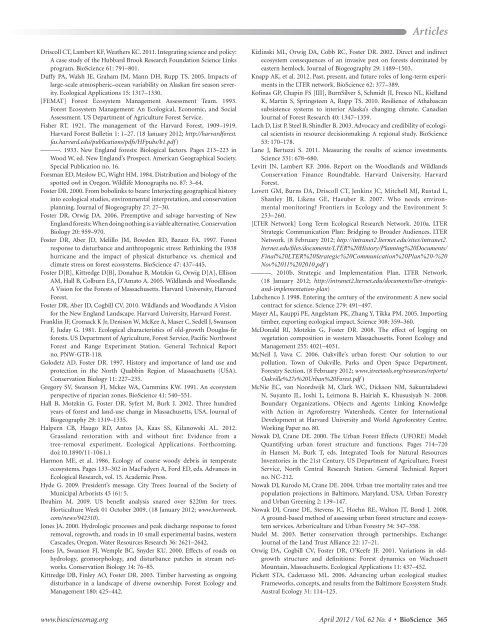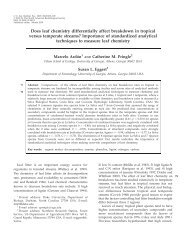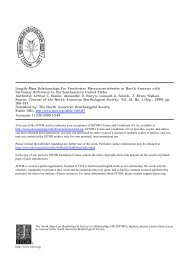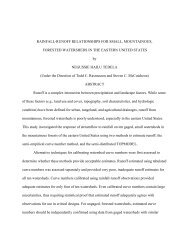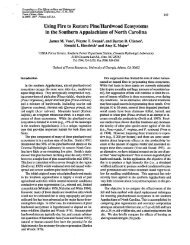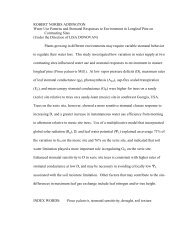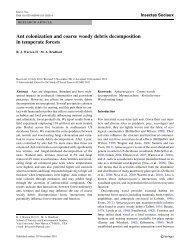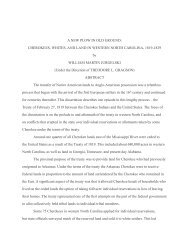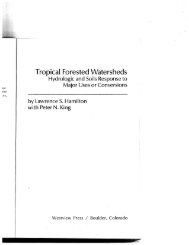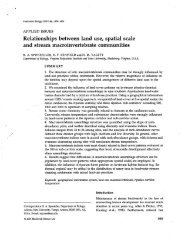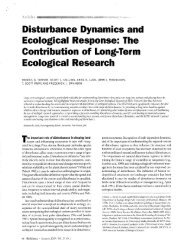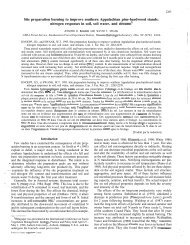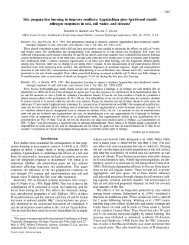biology join - Coweeta LTER - University of Georgia
biology join - Coweeta LTER - University of Georgia
biology join - Coweeta LTER - University of Georgia
Create successful ePaper yourself
Turn your PDF publications into a flip-book with our unique Google optimized e-Paper software.
Driscoll CT, Lambert KF, Weathers KC. 2011. Integrating science and policy:<br />
A case study <strong>of</strong> the Hubbard Brook Research Foundation Science Links<br />
program. BioScience 61: 791–801.<br />
Duffy PA, Walsh JE, Graham JM, Mann DH, Rupp TS. 2005. Impacts <strong>of</strong><br />
large-scale atmospheric–ocean variability on Alaskan fire season severity.<br />
Ecological Applications 15: 1317–1330.<br />
[FEMAT] Forest Ecosystem Management Assessment Team. 1993.<br />
Forest Ecosystem Management: An Ecological, Economic, and Social<br />
Assessment. US Department <strong>of</strong> Agriculture Forest Service.<br />
Fisher RT. 1921. The management <strong>of</strong> the Harvard Forest, 1909–1919.<br />
Harvard Forest Bulletin 1: 1–27. (18 January 2012; http://harvardforest.<br />
fas.harvard.edu/publications/pdfs/HFpubs/b1.pdf )<br />
———. 1933. New England forests: Biological factors. Pages 213–223 in<br />
Wood W, ed. New England’s Prospect. American Geographical Society.<br />
Special Publication no. 16.<br />
Forsman ED, Meslow EC, Wight HM. 1984. Distribution and <strong>biology</strong> <strong>of</strong> the<br />
spotted owl in Oregon. Wildlife Monographs no. 87: 3–64.<br />
Foster DR. 2000. From bobolinks to bears: Interjecting geographical history<br />
into ecological studies, environmental interpretation, and conservation<br />
planning. Journal <strong>of</strong> Biogeography 27: 27–30.<br />
Foster DR, Orwig DA. 2006. Preemptive and salvage harvesting <strong>of</strong> New<br />
England forests: When doing nothing is a viable alternative. Conservation<br />
Biology 20: 959–970.<br />
Foster DR, Aber JD, Melillo JM, Bowden RD, Bazazz FA. 1997. Forest<br />
response to disturbance and anthropogenic stress: Rethinking the 1938<br />
hurricane and the impact <strong>of</strong> physical disturbance vs. chemical and<br />
climate stress on forest ecosystems. BioScience 47: 437–445.<br />
Foster D[R], Kittredge D[B], Donahue B, Motzkin G, Orwig D[A], Ellison<br />
AM, Hall B, Colburn EA, D’Amato A. 2005. Wildlands and Woodlands:<br />
A Vision for the Forests <strong>of</strong> Massachusetts. Harvard <strong>University</strong>, Harvard<br />
Forest.<br />
Foster DR, Aber JD, Cogbill CV. 2010. Wildlands and Woodlands: A Vision<br />
for the New England Landscape. Harvard <strong>University</strong>, Harvard Forest.<br />
Franklin JF, Cromack K Jr, Denison W, McKee A, Maser C, Sedell J, Swanson<br />
F, Juday G. 1981. Ecological characteristics <strong>of</strong> old-growth Douglas-fir<br />
forests. US Department <strong>of</strong> Agriculture, Forest Service, Pacific Northwest<br />
Forest and Range Experiment Station. General Technical Report<br />
no. PNW-GTR-118.<br />
Golodetz AD, Foster DR. 1997. History and importance <strong>of</strong> land use and<br />
protection in the North Quabbin Region <strong>of</strong> Massachusetts (USA).<br />
Conservation Biology 11: 227–235.<br />
Gregory SV, Swanson FJ, Mckee WA, Cummins KW. 1991. An ecosystem<br />
perspective <strong>of</strong> riparian zones. BioScience 41: 540–551.<br />
Hall B, Motzkin G, Foster DR, Syfert M, Burk J. 2002. Three hundred<br />
years <strong>of</strong> forest and land-use change in Massachusetts, USA. Journal <strong>of</strong><br />
Biogeography 29: 1319–1335.<br />
Halpern CB, Haugo RD, Antos JA, Kaas SS, Kilanowski AL. 2012.<br />
Grassland restoration with and without fire: Evidence from a<br />
tree-removal experiment. Ecological Applications. Forthcoming.<br />
doi:10.1890/11-1061.1<br />
Harmon ME, et al. 1986. Ecology <strong>of</strong> coarse woody debris in temperate<br />
ecosystems. Pages 133–302 in MacFadyen A, Ford ED, eds. Advances in<br />
Ecological Research, vol. 15. Academic Press.<br />
Hyde G. 2009. President’s message. City Trees: Journal <strong>of</strong> the Society <strong>of</strong><br />
Municipal Arborists 45 (6): 5.<br />
Ibrahim M. 2009. US benefit analysis snared over $220m for trees.<br />
Horticulture Week 01 October 2009. (18 January 2012; www.hortweek.<br />
com/news/942310).<br />
Jones JA. 2000. Hydrologic processes and peak discharge response to forest<br />
removal, regrowth, and roads in 10 small experimental basins, western<br />
Cascades, Oregon. Water Resources Research 36: 2621–2642.<br />
Jones JA, Swanson FJ, Wemple BC, Snyder KU. 2000. Effects <strong>of</strong> roads on<br />
hydrology, geomorphology, and disturbance patches in stream networks.<br />
Conservation Biology 14: 76–85.<br />
Kittredge DB, Finley AO, Foster DR. 2003. Timber harvesting as ongoing<br />
disturbance in a landscape <strong>of</strong> diverse ownership. Forest Ecology and<br />
Management 180: 425–442.<br />
Articles<br />
Kizlinski ML, Orwig DA, Cobb RC, Foster DR. 2002. Direct and indirect<br />
ecosystem consequences <strong>of</strong> an invasive pest on forests dominated by<br />
eastern hemlock. Journal <strong>of</strong> Biogeography 29: 1489–1503.<br />
Knapp AK, et al. 2012. Past, present, and future roles <strong>of</strong> long-term experiments<br />
in the <strong>LTER</strong> network. BioScience 62: 377–389.<br />
K<strong>of</strong>inas GP, Chapin FS [III], BurnSilver S, Schmidt JI, Fresco NL, Kielland<br />
K, Martin S, Springsteen A, Rupp TS. 2010. Resilience <strong>of</strong> Athabascan<br />
subsistence systems to interior Alaska’s changing climate. Canadian<br />
Journal <strong>of</strong> Forest Research 40: 1347–1359.<br />
Lach D, List P, Steel B, Shindler B. 2003. Advocacy and credibility <strong>of</strong> ecological<br />
scientists in resource decisionmaking: A regional study. BioScience<br />
53: 170–178.<br />
Lane J, Bertuzzi S. 2011. Measuring the results <strong>of</strong> science investments.<br />
Science 331: 678–680.<br />
Levitt JN, Lambert KF. 2006. Report on the Woodlands and Wildlands<br />
Conservation Finance Roundtable. Harvard <strong>University</strong>, Harvard<br />
Forest.<br />
Lovett GM, Burns DA, Driscoll CT, Jenkins JC, Mitchell MJ, Rustad L,<br />
Shanley JB, Likens GE, Haeuber R. 2007. Who needs environmental<br />
monitoring? Frontiers in Ecology and the Environment 5:<br />
253–260.<br />
[<strong>LTER</strong> Network] Long Term Ecological Research Network. 2010a. <strong>LTER</strong><br />
Strategic Communication Plan: Bridging to Broader Audiences. <strong>LTER</strong><br />
Network. (8 February 2012; http://intranet2.lternet.edu/sites/intranet2.<br />
lternet.edu/files/documents/<strong>LTER</strong>%20History/Planning%20Documents/<br />
Final%20<strong>LTER</strong>%20Strategic%20Communication%20Plan%20-%20<br />
Nov%2011%202010.pdf )<br />
———. 2010b. Strategic and Implementation Plan. <strong>LTER</strong> Network.<br />
(18 January 2012; http://intranet2.lternet.edu/documents/lter-strategicand-implementation-plan)<br />
Lubchenco J. 1998. Entering the century <strong>of</strong> the environment: A new social<br />
contract for science. Science 279: 491–497.<br />
Mayer AL, Kauppi PE, Angelstam PK, Zhang Y, Tikka PM. 2005. Importing<br />
timber, exporting ecological impact. Science 308: 359–360.<br />
McDonald RI, Motzkin G, Foster DR. 2008. The effect <strong>of</strong> logging on<br />
vegetation composition in western Massachusetts. Forest Ecology and<br />
Management 255: 4021–4031.<br />
McNeil J, Vava C. 2006. Oakville’s urban forest: Our solution to our<br />
pollution. Town <strong>of</strong> Oakville, Parks and Open Space Department,<br />
Forestry Section. (8 February 2012; www.itreetools.org/resources/reports/<br />
Oakville%27s%20Urban%20Forest.pdf )<br />
McNie EC, van Noordwijk M, Clark WC, Dickson NM, Sakuntaladewi<br />
N, Suyanto JL, Joshi L, Leimona B, Hairiah K, Khususiyah N. 2008.<br />
Boundary Organizations, Objects and Agents: Linking Knowledge<br />
with Action in Agr<strong>of</strong>orestry Watersheds. Center for International<br />
Development at Harvard <strong>University</strong> and World Agr<strong>of</strong>orestry Centre.<br />
Working Paper no. 80.<br />
Nowak DJ, Crane DE. 2000. The Urban Forest Effects (UFORE) Model:<br />
Quantifying urban forest structure and functions. Pages 714–720<br />
in Hansen M, Burk T, eds. Integrated Tools for Natural Resources<br />
Inventories in the 21st Century. US Department <strong>of</strong> Agriculture, Forest<br />
Service, North Central Research Station. General Technical Report<br />
no. NC-212.<br />
Nowak DJ, Kurodo M, Crane DE. 2004. Urban tree mortality rates and tree<br />
population projections in Baltimore, Maryland, USA. Urban Forestry<br />
and Urban Greening 2: 139–147.<br />
Nowak DJ, Crane DE, Stevens JC, Hoehn RE, Walton JT, Bond J. 2008.<br />
A ground-based method <strong>of</strong> assessing urban forest structure and ecosystem<br />
services. Arboriculture and Urban Forestry 34: 347–358.<br />
Nudel M. 2003. Better conservation through partnerships. Exchange:<br />
Journal <strong>of</strong> the Land Trust Alliance 22: 17–21.<br />
Orwig DA, Cogbill CV, Foster DR, O’Keefe JF. 2001. Variations in oldgrowth<br />
structure and definitions: Forest dynamics on Wachusett<br />
Mountain, Massachusetts. Ecological Applications 11: 437–452.<br />
Pickett STA, Cadenasso ML. 2006. Advancing urban ecological studies:<br />
Frameworks, concepts, and results from the Baltimore Ecosystem Study.<br />
Austral Ecology 31: 114–125.<br />
www.biosciencemag.org April 2012 / Vol. 62 No. 4 • BioScience 365


